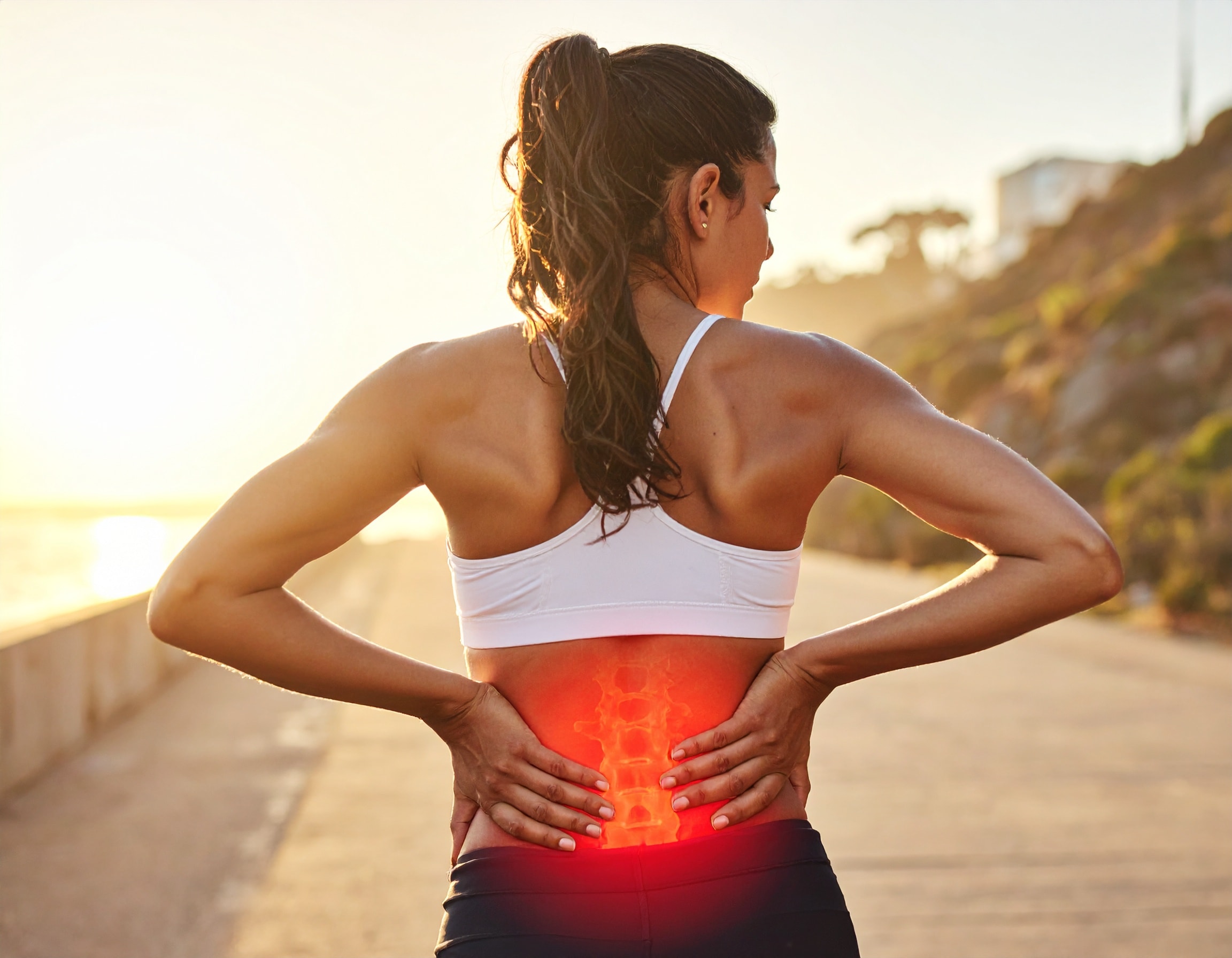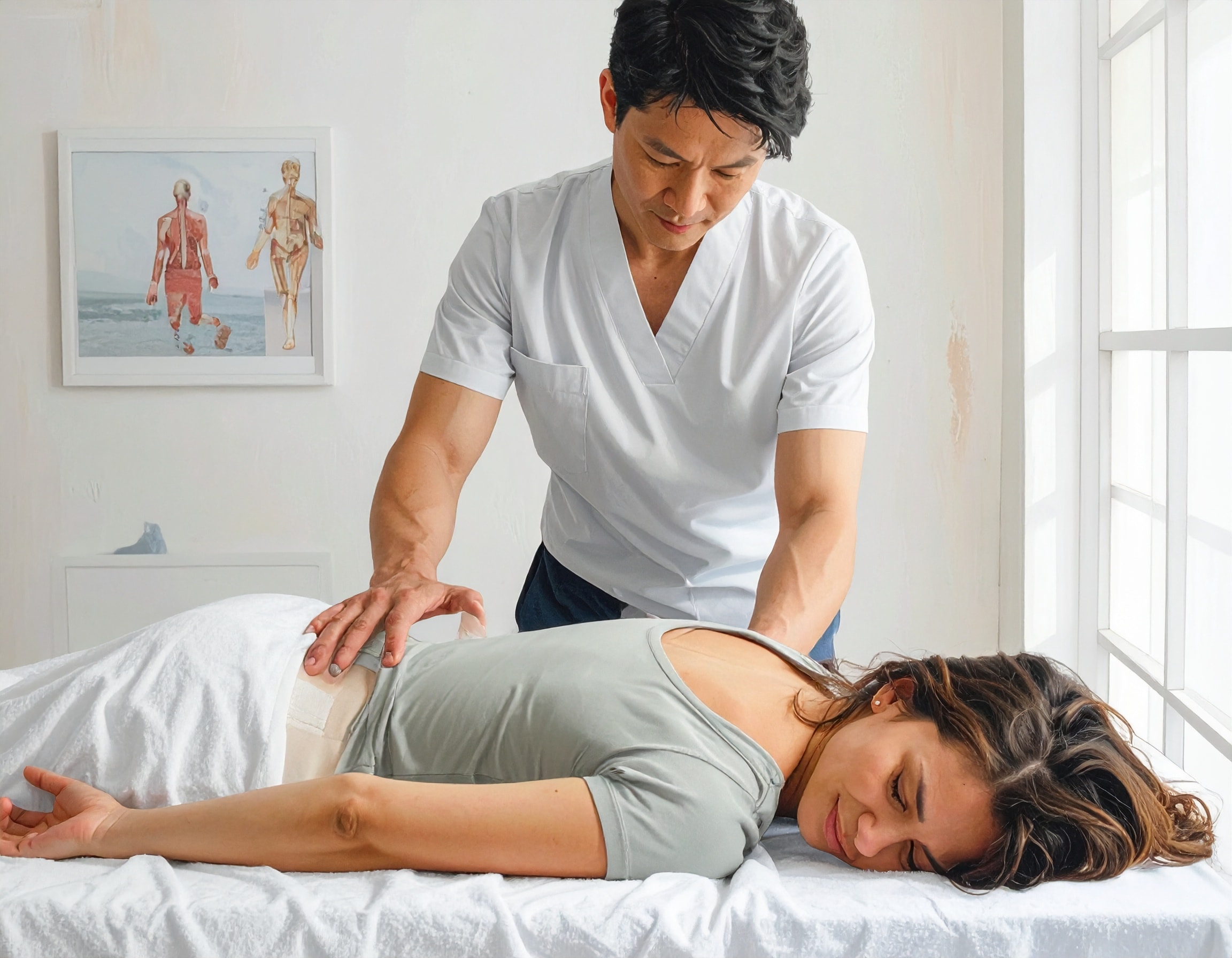Back pain ranges from mild to severe, lasting from days to a lifetime. This overview addresses its causes, symptoms, relief strategies, and when to seek help.
Understanding how back pain develops requires looking at both the anatomical and lifestyle factors that contribute. The back supports most body weight, making it vulnerable to pain. Many cases resolve quickly, though some require further treatment.
Before exploring specific causes, it’s important to define what back pain is and why it matters.
Back pain is discomfort in the lumbar spine, often involving muscles, ligaments, discs or nerves. The lumbar region, located below the ribcage, is commonly affected. Causes include muscle strain, poor posture, injury, herniated discs, arthritis and sciatica. Prolonged sitting, heavy lifting and sudden movements can aggravate symptoms. Because back pain can disrupt daily life, treatment and prevention is key.
Back pain presents as discomfort, tension or stiffness between the lower rib cage and the buttocks. It can be a dull ache, sharp stabbing sensation or radiating pain to the legs. Back pain is acute if it lasts a few days to weeks or chronic if it’s more than 3 months.
Back pain is the number one cause of missed workdays and disability worldwide, affecting almost 540 million people according to the Global Burden of Disease Study. Most people will experience lower back pain at some point in their lives.
Recognizing when pain begins is crucial for timely medical care and symptom management. Next, let’s examine the main causes and risk factors associated with lack pain.
Common Causes and Risk Factors of Back Pain
There are many causes and risk factors for back pain. Being a healthy weight helps reduce risk. Degenerative conditions like osteoarthritis and disc degeneration are common causes, especially in older adults. Identifying the underlying cause is important for a treatment plan. Existing health issues should also be considered for effective management.
Back pain is typically pain diagnosed through a comprehensive health history and physical exam, with imaging tests used selectively based on the initial clinical evaluation.
1. Muscle Strains and Ligament Sprains
Muscle strains and ligament sprains are the most common causes of back pain. These injuries, often called back strain, typically result from sudden movements, heavy lifting, or overuse. Poor posture, weak core muscles, and improper lifting techniques increase risk. Symptoms include localized pain, stiffness, and spasms that worsen with movement.
2.) Herniated or Bulging Discs.
Spinal discs are rubbery cushions between the bones (vertebrae) of your spine. A herniated disc, also called a slipped or ruptured disc, occurs when part of the disc pushes out through a tear in its tough exterior. A bulging disc is when the disc swells beyond its normal size. Either can compress nerves and cause intense pain, numbness, or tingling known as sciatica, which is pain that radiates along the path of the sciatic nerve down the leg. Causes are trauma, age-related wear and tear, and repeated strain. Pain worsens with sitting, coughing, or bending forward. Diagnosis involves a detailed health history and physical examination.
3. Degenerative Disc Disease
Aging causes spinal discs to lose hydration and elasticity, sometimes leading to degenerative disc disease. This can cause pain, inflammation, and spinal instability, often resulting in chronic back pain that worsens with activity. Severe cases may need comprehensive management.
4. Spinal Stenosis
Spinal stenosis is when the spinal canal narrows and compresses nerves, frequently occurring in adults over 50 due to osteoarthritis, disc degeneration, or thickened ligaments. Symptoms are pain, numbness, tingling, or weakness in the back and legs, especially with walking or standing. Severe or prolonged compression may require urgent medical attention. If pain medication stops working or daily activities are affected, consult a healthcare provider for further evaluation and treatment options.
5. Poor Posture and Sedentary Lifestyle
Prolonged sitting especially with poor posture strains back muscles and spinal structures. Inactivity weakens core muscles and reduces spinal support. Slouching, inadequate seating and poor workstation ergonomics can worsen symptoms. Good posture helps relieve discomfort and improve mobility.
Adopting lifestyle changes, such as increasing activity and improving posture, is important for both preventing and managing lower back pain.
6. Psychological and Emotional Stress
Mental health influences pain perception. Chronic stress, anxiety, and depression can increase muscle tension and lower pain tolerance, leading to tightness in the neck, shoulders, and back. Psychological factors play a role in our experience and management of pain.

Back Pain Symptoms
Common Symptoms
- Dull, aching, sharp pain or severe pain in the back
- Stiffness or reduced range of motion
- Muscle spasms or tenderness
- Pain that radiates into the leg – may indicate nerve involvement
- Difficulty standing up straight or walking for extended periods
Certain symptoms, such as tingling, burning sensations, or pain radiating to other areas, may identify the underlying cause and severity of back pain.
Red Flag Symptoms
- Numbness or tingling in legs or feet
- Muscle weakness in lower extremities
- Loss of bowel or bladder control
- Pain that wakes you at night
- Unexplained weight loss or cancer history, or recent trauma, is concerning.
Back Pain Relief
1. Ice and Heat
Cold therapy is good for acute injuries, including sudden or short-term (acute) back pain, as it reduces inflammation (swelling) and numbs sore tissues. ‘Acute’ means the pain came on suddenly and usually resolves within a few weeks. Apply ice for 15 to 20 minutes every 2 to 3 hours for the first 48 hours. Heat therapy improves circulation (blood flow) and relaxes tight muscles, making it good for long-term (chronic) tension or stiffness. Use a heating pad, warm baths or heat wraps for 15 to 30 minutes at a time.
2. Stay Active
Extended bed rest is not recommended for back pain. Returning to your usual activities as soon as possible supports recovery and prevents symptoms from worsening. Gentle movement maintains flexibility, reduces inflammation and prevents stiffness. Walking, swimming or light yoga are good options. Avoid high impact activities until symptoms improve. A physical therapist can guide you in safe exercises and stretches to strengthen core muscles and support spinal health.
Regular physical activity is important for both recovery and prevention of back pain.
Exercise is important for long term back health. Make it a habit to maintain a healthy back and help prevent future pain.
3. Stretch and Mobilize
Regular stretching enhances flexibility, reduces muscle tightness and supports spinal alignment. Recommended gentle, low-impact exercises for back pain are:
See Recommended Products
- Cat-cow pose
- Knee-to-chest stretch
- Seated spinal twist
- Hamstring stretch
- Tai chi
Hold each stretch for 20-30 seconds and repeat 2-3 times daily.
To prevent stiffness and promote healing, avoid staying in one position for extended periods during your recovery.
4. Support Your Posture
Good posture reduces spinal strain while sitting or standing. Use a lumbar roll or ergonomic chair for support, keep your feet flat on the floor and avoid crossing your legs. Adjust monitors to eye level and take breaks every 30 to 60 minutes to stand or stretch.
Professional Treatments for Chronic Back Pain
1. Physical Therapy
A customized physical therapy program focuses on strengthening the abdominal muscles (front of the abdomen) and back muscles to improve core stability, flexibility, and correct imbalances. Therapists use techniques such as therapeutic exercises, manual therapy (hands-on treatments), and posture correction to relieve pain, reduce discomfort, and improve mobility.
2. Chiropractic Care
Chiropractors do spinal adjustments, which are manual movements of the back bones (vertebrae) to improve their position and movement. This can help reduce pressure on nerves and increase mobility. Chiropractic care may be combined with stretching, exercise, and lifestyle advice for long term benefits.
Effectiveness of chiropractic care for back pain depends on individual circumstances, including underlying causes and severity. Before treatment patients should inform their chiropractor of any health issues to ensure safe and personalized care.
3. Massage
Massage helps to relieve muscle tension, improve circulation and reduce stress related pain. Techniques such as deep tissue massage or trigger point therapy target specific muscle groups that contribute to back pain. Massage can also be used in conjunction with other treatments for chronic pain. Pain medicine may also be used alongside massage and other therapies to relieve symptoms and support recovery.
Corticosteroid Injections
Corticosteroid injections (medication injected into the area around the spine to reduce inflammation) may provide temporary relief. Before considering surgical options like spinal decompression (surgery to relieve pressure) or fusion (surgery to join two spine bones), explore other treatments like physical therapy and medication. Always try non-invasive options first and consult a spine specialist for evaluation.

How to Prevent Back Pain Flare-Ups
Strengthen Your Core
Strong core muscles stabilize the spine. Do planks, bird-dogs, or bridges weekly to build endurance.
A stronger core helps address and prevent back pain.
Lift With Care
Lift by bending your knees, not your waist. Keep objects close and avoid twisting.
Improve Ergonomics
Make sure your desk setup promotes good posture. Use adjustable chairs, footrests and monitor risers to reduce spinal stress.
Manage Stress
Chronic stress can tighten muscles and increase pain sensitivity. Practice deep breathing, meditation or gentle movement to relax your body and mind.
FAQs
How do I decompress my back?
Try the knee-to-chest stretch: lie on your back, bring one knee towards your chest, hold 15-30 seconds, then switch. You can also do gentle pelvic tilts and a child’s-pose stretch to reduce pressure and ease stiffness.
What causes back pain?
Common causes include muscle strain, poor posture, disc changes, arthritis and overuse. Less common causes include nerve irritation or fractures. Finding the cause helps you choose the right treatment.
What is sciatica?
Sciatica is nerve pain that usually starts in the lower back and travels down the leg. It’s often due to a disc bulge or bone spur touching a nerve root. Most cases improve with time and guided exercise.
How should I sleep with back pain?
Sleep on your side with a pillow between your knees or on your back with a pillow under your knees. Use a supportive mattress and keep your spine neutral – avoid stomach sleeping if it makes your pain worse.
Which exercises help?
Start with gentle walking, pelvic tilts and core-activation (e.g. dead bugs, bird-dogs). Add hip and hamstring mobility. Go slow and stop if you spike your pain.
When should I see a doctor?
Urgent care for severe pain after injury, loss of bladder/bowel control, leg weakness, fever or unexplained weight loss. See a clinician if pain lasts more than a few days, keeps coming back or limits your daily activities.

